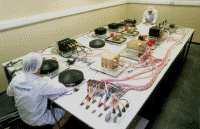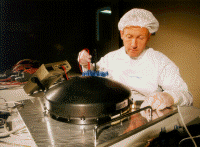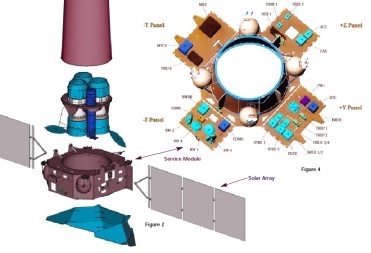Engineering
Structural Design
The spacecraft structure, like any other structure, is there primarily to guarantee the integrity of the spacecraft under any loading, such as during handling, testing and launch. In addition, it must allow the spacecraft to serve as an optical bench for a telescope and therefore the structure must provide the necessary thermo-elastic stability in orbit. In the case of XMM-Newton, this led immediately to the selection of ultra-high-modulus carbon-fibre composites (low thermal expansion) for the main structural elements. Another advantage of this material is its very high modulus of elasticity. This limits the total structural mass needed to ensure the structure's stiffness.
These two favourable qualities of this carbon-fibre material, plus its low mass, have led to its widespread use on XMM-Newton, albeit for different reasons in different parts. For instance, for the telescope tube and the mirror support platform, a carbon-fibre composite was necessary for thermo-elastic reasons. A strongly directional lay-up made it possible to meet the requirements, whereas the mass could be kept low. On the other hand, for the central cone of the Service Module, the stiffness required was the main reason for using a carbon-fibre composite.
In complex items, such as the mirror support platform, the joints that are necessarily made out of metal degraded the intended high thermo-elastic stability to such a level that active thermal control was necessary. Here, a carbon-fibre composite was selected for its high stiffness and strength. Other parts outside the optical path were made of aluminium for reasons of thermal conductivity (honeycomb for Service Module side panels), light-tightness and ease of production (telescope Sun shield, outgassing baffle).
Service Module
The Service Module consists of a closed box, shaped around a hollow central cone, and comprises the lower and upper platforms as well as four side panels, on which all satellite bus units are installed. The functions provided by the Service Module (SVM) are:
- The primary and secondary structures to interface with the launcher adapter, to support the subsystem units, and to interface with and support the Mirror Support Platform and the Telescope Tube
- The thermal control to maintain the SVM units and equipment within specified temperature limits, and to provide a very strictly controlled thermal environment for the mirror assemblies
- The Attitude and Orbit Control System (AOCS) for precise pointing/slewing in all operational modes, and for the performance of orbit acquisition/maintenance via the RCS propulsion system (reaction Control System)
- The On-Board Data Handling (OBHD) for the decoding of ground telecommands, the distribution of ground on-board commands, the sampling and formatting of telemetry data, and central on-board time distribution
- The Radio Frequency System (RFS), operating in S-band, ensuring communications with the ground stations and providing a ranging mode for orbit determination
- The Electrical Power Subsystem (EPSS) for the generation and distribution of regulated power to all equipment via a 28 V main bus
Attitude and Orbital Control Systems (AOCS)
The orientation of a satellite in space is crucial, whether it be for telecommunications or Earth observation craft, or for astronomy missions like XMM-Newton. ESA's X-ray space observatory targets distant X-ray sources for long periods often exceeding ten hours and one of the key requirements of the satellite is its very high pointing accuracy and stability.
This high precision of control in orbit is the responsibility of the satellite's Attitude and Orbit Control System (AOCS). This major subsystem has been provided by Matra Marconi Space (MMS) UK and constitutes the principal contribution from the United Kingdom to the XMM-Newton mission.
 |
|
Attitude and Orbit Control System (AOCS) (courtesy of MMS) |
The pointing accuracy of the 10 m long XMM-Newton is 0.25 arcsec over a 10-second interval. "In terrestrial terms, this is equivalent to someone in Bristol looking at a melon on Saint Paul's cathedral in London using a handheld telescope and seeing it without the slightest jitter" explains Mike Backler, the MMS Project Manager for XMM-Newton.
 |
|
Reaction wheel (courtesy of MMS) |
On the basis of data supplied by a star-tracker telescope, which recognises the different star formations in its field of view, the AOCS computers calculate the appropriate momentum of the reaction wheels for precision manoeuvring of the spacecraft during observations or to change the target. The maximum rotation speed of the reaction wheels is 4000 rpm. For redundancy XMM-Newton carries a second star-tracker telescope.
The fully redundant AOCS represents some 100 kg of electronics: a dozen black equipment boxes, containing the computers, reaction wheels, Sun and inertial sensors, power supplies and associated cabling. Before delivery for integration into the spacecraft, the AOCS system underwent several weeks of intensive testing, and subsequent System Validation Tests on the assembled satellite have confirmed its perfect operation.
Fail-safe approach
The design of the AOCS has been driven by a fail-safe approach. All eventual failures must be detected. The principal component of the AOCS is its flight Failure Detection and Correction Electronics unit. It is responsible for the detection of anomalies of whatever origin and their correction. Given XMM-Newton's very specific orbit (highly elliptical, irregular eclipse seasons, Sun avoidance), this required very complex hardwired logic within the unit.
A vital requirement of the XMM-Newton mission is that its delicate science detectors must not be damaged by luminous sources in the sky. The telescope's longitudinal axis is prevented from ever coming within 70° of the Sun's direction. Likewise it will never point to within 42.5° of the Earth or 22° of the Moon during scientific observations. In addition, a solar aspect angle within the range 70-110 must be maintained at all times. Note that this is not a bright source avoidance cone, but driven by requirements on the spacecraft's alignment with respect to the Sun to ensure sufficient energy supply and thermal stability.
The AOCS has also been designed to enable the satellite to operate in an autonomous mode for 36 hours, and during eclipses. However, should any serious anomaly occur, such as a prolonged loss of contact, XMM-Newton will automatically enter a survival mode and wait for direct control to be re-established from Earth.
The Attitude and Orbit Control System entered into play seconds after Ariane 5 released XMM-Newton. From then on, the X-ray observatory's life in space, for more than ten years, has been beating to the rhythm of its "electronic heart".
Thermal Control
The mirror shells of the mirror modules have to be kept at an average temperature of 20 °C, with spatial maximum temperature differences of ±2 °C in order to limit thermo-elastic deformations. Therefore, the mirror support platform is maintained almost isothermal, with deviations of less than ±2 °C. On the other hand, the Service Module equipment presents quite standard temperature ranges and attention is therefore mainly paid to simplicity and reliability.
The thermal design of XMM-Newton takes full advantage of the stable environment provided by its high-altitude, long-period orbit and by the limited variation of solar attitude angles (120° pitch combined with 120° roll). In fact, the Earth albedo and infrared heat fluxes are negligible along the largest part of its high-altitude orbit. Only at perigee passes, when the altitude reduces to 7000 km, XMM-Newton's thermal stability is slightly affected by the influence of the Earth.
The largest thermal perturbations occur during the eclipse seasons, when the satellite does not receive the Sun's energy for a maximum period of 1.7 h (although, on average, the eclipses are much shorter). However, eclipses always occur below the minimum altitude that is required for observation (40 000 km), leaving time for the spacecraft to recover its temperature stability. Boost heating performed before and after the eclipses by means of heater helps to reduce the time needed for recovery of the temperature drop caused by eclipses.
In order to cope with all orbital perturbations and with changes of satellite attitude, the telescope tube is completely insulated from the external environment and the heater power that is dissipated inside it can be almost continuously adjusted to compensate for changes.

